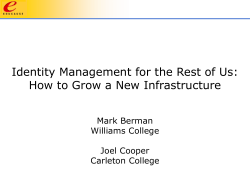
Synchome: Evaluation of Synchronization Application for Mobile
Synchome Evaluation of Synchronization Application for Mobile Content Retrieval Nina Mujkanovic Computer Networks and Distributed Systems University of Berne 16.03.2015 Roadmap > What is CCNx > CCNx synchronization protocol > Problem statement > Synchome design > Evaluation 2 What is CCNx > CCN = Content Centered Networking > Communication based on names > Everything is a message – Interest and Data messages > CCNx = open source implementation of CCN 3 CCNx synchronization protocol > Keeps data automatically synchronized > Data is stored in persistent storage - repositories > User defines what to synchronize > New content is synchronized between participating hosts 4 CCNx synchronization protocol 5 Problem statement > Synchronizing hosts must be in same local subnet or connected by tunnel → additional overhead for mobile clients > Synchronization runs infinitely unless aborted by user → continued energy expenditure > Synchronization protocol continues exchanging messages when not actively synchronizing content → inefficient for mobile clients 6 Synchome > Synchronization protocol for mobile clients > Registers hosts IP addresses as locators in CCNx routing tables > Detects synchronization disrupts (e.g. no AP in vicinity) and re-registers hosts if necessary > Exits once synchronization of content is finished 7 Synchome > Consists of: > Client application (registers server, sends initialization Interest to server, runs monitoring application, exits once finished succesfully) > Server application (home repository, constantly running and listening for Interests) > Synchronization monitoring application 8 Synchome 9 Evaluation > synchome vs. ccnsyncslice (implementation of synchronization protocol) > Synchronization of content with/without periods where no new content is available > Measure synchronization time > Use CCNx log to analyze Interest and Data messages passed between client and host 10 Evaluation > Evaluated on UBELIX using DCE-ns3 11 CCNx synchronization protocol > Keeps information stored in synchronization tree. Parent folder hash is tree roothash, subfolder hashes are child nodes, etc > Rootadvise carrying roothash sent every 20 seconds. If roothashes differ, new content available > When synchronizing, rootadvise Interests are exchanged every second > Node fetch Interests carrying child node hashes exchanged simultaneously with content until synchronization finished 12 CCNx synchronization protocol Image courtesy of http://static.searchengineguide.com/images/directory-ideal.jpg 13 Scenario 1 > Initialize CCNx and repositories > Add files sized 1, 5 or 10MB to repository > 5 files each added to 1, 2 or 3 collections > Run synchome/ccnsyncslice until finished synchronization and stop simulation 14 2 collections, 1-5-10MB 15 3 collections, 10MB 16 Scenario 2 > Synchronize for 24 hours > Add new content (filesize 1 or 2MB) every 900, 1800 or 3600 seconds > Ccnsyncslice constantly running > Synchome is initialized when new content is available and exits when synchronization is finished 17 Message types > Interest_to messages: Interests sent out by host. May be Rootadvise or Node fetch Interests, or requests for content. > Content_to messages: Data messages sent out by host. May carry replies to Rootadvise or Node fetch Interests, or content. 18 Client Interest messages 19 Client Data messages 20 Client Data messages > Ccnsyncslice sends out around 50% more Data messages than synchome > Number of transferred content segments stays constantly in same range > So what is causing the increase? 21 Client Rootadvise replies 22 Client Node fetch replies 23 Conclusions > Synchome generates far less messages than ccnsyncslice. > The larger the content generation interval, the better synchome performs compared to ccnsyncslice > Exchange of Node fetch Interests has influence on synchronization time > Mean runtime difference is nearly negligible between applications. Ccnsyncslice always displays higher maximal runtime. 24 Questions? 25
© Copyright 2025















